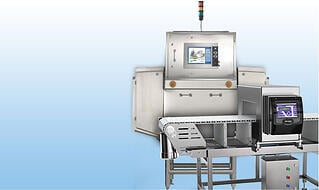 For years now, x-ray product inspection systems have been a trusted inspection technology for the packaged food industry.
For years now, x-ray product inspection systems have been a trusted inspection technology for the packaged food industry.
However, in recent years, there have been new developments in x-ray inspection technologies, creating new kinds of x-ray machines that can provide new benefits for food makers. So, what are the different kinds of x-ray inspection devices, and how can they benefit your company?
Current x-ray technologies fall into two broad categories:
- Single-energy x-ray machines
- Dual-energy x-ray machines
Within the dual-energy x-ray machine category, there is further separation between MDX (material discrimination x-ray) and DEXA (dual-energy x-ray absorptiometry) technologies.
Benefits of Single-Energy X-Ray Machines
When most people think of x-ray machines, they’re thinking of the traditional single-energy system. This system uses a single beam of x-rays to take a snapshot of a product and create a grayscale image for analysis.
This system relies on object density to identify contaminants. In simple products with a consistent density distribution, this system is highly effective at identifying contaminants.
In products with complicated, random shape patterns (such as cereal), however, single-energy systems tend to have a difficult time picking out contaminants from product. Also, these systems would have difficulty detecting low-density materials such as:
- Glass shards
- Some rocks
- Plastics
- Low-density rubber
Despite these vulnerabilities, single-energy systems remain highly effective at spotting small, high-density objects in food packages. In fact, singe-energy x-rays are more effective at this task than either of the dual-energy technologies currently available.
Benefits of MDX Machines
Unlike traditional x-ray systems, MDX systems use two separate x-ray energy spectrums to help discriminate between high and low channel x-rays. A dual-layer detector is also used to take advantage of this system.
This setup allows the MDX scanner to actually differentiate between organic and inorganic materials based on their chemical composition (a.k.a. atomic number) rather than relying on a simple density scan.
Because of their ability to read the chemical composition of the products they scan, MDX machines can detect a wider range of contaminant types than single-energy systems can. For example, MDX technology can detect:
- Rocks
- Rubber
- Bone
- Glass
- Plastics
Just to name a few. These systems can also detect contaminants through a wider variety of packaging types, such as cardboard or sandwich packaging that would interfere with traditional x-ray systems.
With a wider variety of detectable contaminants and greater reliability in products with highly variable density, MDX technology is a very useful product inspection technology for your food quality assurance process.
Benefits of DEXA Technology
Like MDX technology, DEXA technology uses a dual-energy x-ray emitter and a dual-layer detector. Also like MDX technology, DEXA technology checks not the density of a product, but its chemical composition.
However, where DEXA machines differ from MDX machines is in its application. DEXA machines are specifically optimized for the processed meat industry to scan the chemical lean value of meat as well as moisture and protein.
These systems provide meat packaging companies the ability to measure the fat content of their meat on the fly, measuring 100% of the meat that they process in real time. This helps packaged meat processors meet increasingly strict standards for their industry when it comes to reporting fat content in their meat. It also helps producers reduce the product cost and improve their least cost formulating.
Other, lab-based methods of testing the CL value of meat take much longer, and often destroy the sample being tested. This means that only a small fraction of the meat produced is tested using these methods, which can result in an inaccurate assessment of the CL value of a meat package. If discovered by a client, this could result in a recall or demand for a refund.
At the same time that these systems are evaluating the chemical lean value of meat, they’re also able to check for foreign bodies and the weight of a meat package.
All in all, DEXA technology is indispensable for packaged meat vendors looking to tighten their quality control process.
These are just a few of the basic benefits of using each of the different x-ray product inspection technologies for your quality control process. While no system will prevent 100% of all forms of product contamination, these x-ray inspection technologies can help you minimize the chance of a contaminated product leaving your facility.




